Crape Myrtle Bark Scale Identification and Control
Crape myrtle bark scale (CMBS) is a serious new threat to southern crape myrtles. It threatens to turn what has historically been a beautiful, low-maintenance landscape tree into an unsightly, high-maintenance landscape tree. This nonnative scale was first detected in the United States in Texas in 2004 and was first found in Mississippi in spring 2015. It is now well established in more than 20 Mississippi counties and will likely continue to spread. All members of Mississippi’s gardening and landscaping community need to know how to identify and control CMBS in order to help slow its spread and reduce its impact.
There are few natural enemies here in the United States, and this allows CMBS to build to unusually high numbers on infested plants. It is not unusual for heavily infested plants to have branches and twigs that are completely encrusted with scale. The nymphs produce large quantities of honeydew, and this results in heavy accumulations of sooty mold on the leaves, twigs, and trunks of infested plants, as well as on nearby low-growing plants and surrounding grass and mulch. The end result is a black and ugly crape myrtle (due to heavy sooty mold accumulation) that produces fewer and smaller blooms. Unless they are treated, crape myrtles heavily infested with CMBS become a landscape eyesore. Effective treatments are available, but they are relatively costly and do not provide 100 percent control, meaning that treatments must be reapplied each year.
Crape myrtles that are heavily infested with CMBS are covered with sooty mold and bloom poorly. Note that the mulch underneath this tree is also black with sooty mold. Even mulch and plants growing beneath crape myrtles heavily infested with crape myrtle bark scale will be covered with sooty mold.

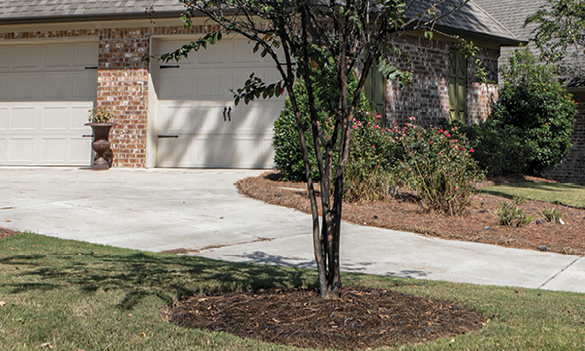
Scouting and Identification
Heavy infestations of crape myrtle bark scale are easy to spot and identify:
Sooty mold alone is not a definite indication of CMBS, but if you also find white, felt-covered scales that bleed pink when punctured, you can be sure you have found crape myrtle bark scale. Heavy infestations of crape myrtle aphids can also cause trees to be covered with black sooty mold, but any crape myrtle that is covered with sooty mold should be carefully examined for CMBS. Sometimes trees have heavy infestations of aphids and CMBS. Aphids will only feed on the leaves; CMBS will feed mainly on the twigs, branches, and trunk, and rarely on the leaves.
Although CMBS is easy to detect and identify on heavily infested plants, low infestations on recently infested plants are hard to spot. Inspect plants especially carefully before purchasing. Don’t just look at the trunk and lower limbs when checking large trees in the landscape. Be aware that most of the scale will be on small twigs and branches in the upper part of the tree, and check these areas as well.
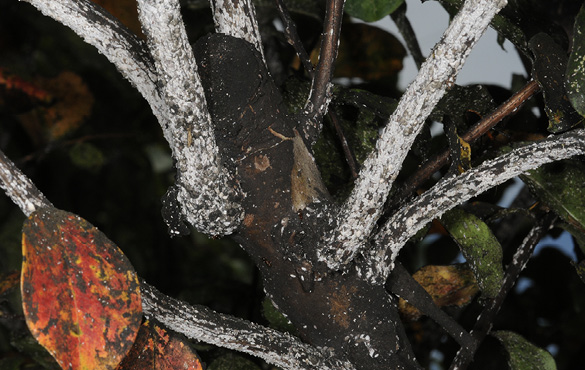


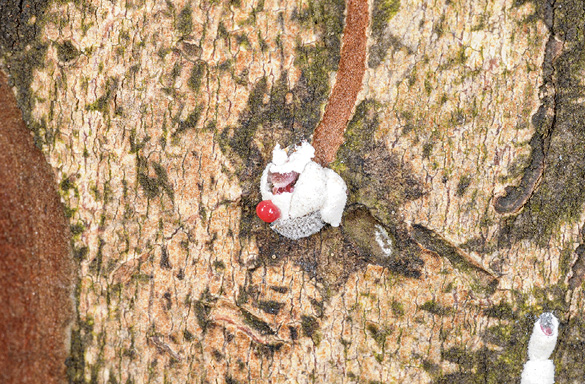
Biology
Crape myrtle bark scale, Eriococcus lagerstroemiae, belongs to a special group of scale insects known as felt scales. Adult females produce a white, felt-like sac around their bodies and lay approximately 100 to 300 pink eggs inside this sac. The female’s body shrinks as eggs are produced. Eggs hatch into tiny pink crawlers, and the older nymphs are pink, gray, or brown. Adult males, which are rarely seen, are winged and mobile.
Based on information from similar plant growth zones in China and observations reported from other infested states here in the United States, it appears that CMBS will complete two to four generations per year in the Southeast. Overwintering can occur in any life stage but especially as nymphs.
CMBS does not spread by flying because only males have wings. Long-range dispersal occurs through human transport of infested plants. Short-range dispersal can potentially occur by wind or as a result of crawlers being transported on birds or flying insects, as well as by gardeners and landscape maintenance equipment and personnel. CMBS readily spreads from tree to tree once it becomes established in an area, even when trees are hundreds of feet apart. CMBS is primarily a pest of crape myrtles in the United States, though infestations have also been detected on American beautyberry. But this insect has been found on many other species of plants in other regions of the world, and many of these reported hosts are grown in the United States.
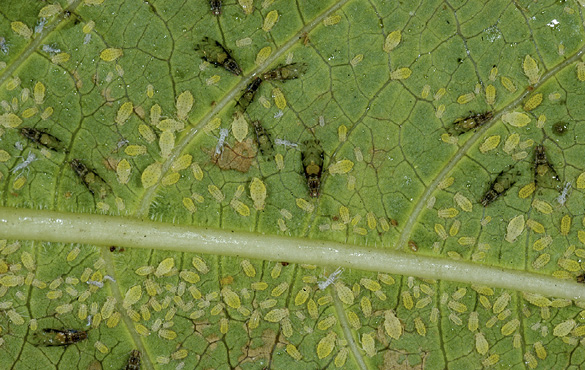
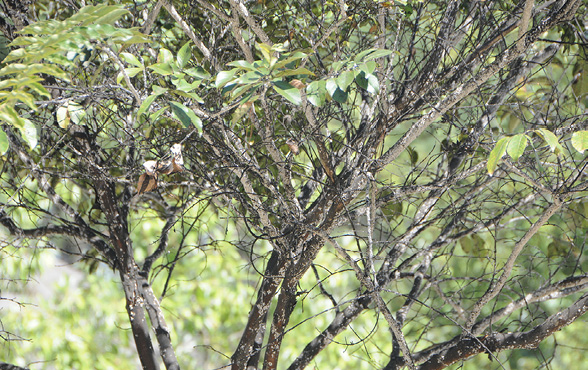
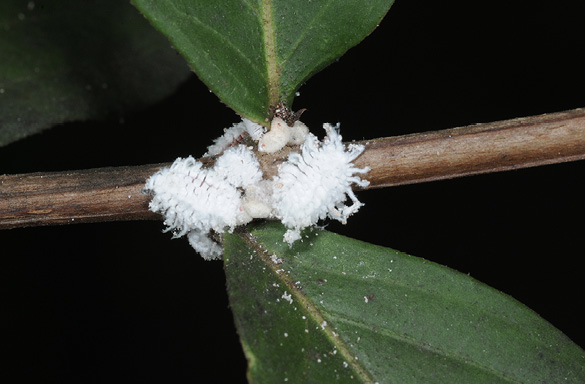
A Ray of Hope
As is often the case with new, nonnative insect pests, CMBS has few natural enemies here in the United States, and this is why they are able to reach such high, damaging populations. There are several species of lady beetles, including the nonnative, multicolored Asian lady beetle, the twice stabbed lady beetle, and the Hyperaspis lady beetle, that feed on CMBS, and large numbers of lady beetles can usually be found on heavily infested trees. But lady beetle population growth tends to lag behind that of the bark scale, and lady beetle predation may not be adequate to prevent development of heavy CMBS infestations and heavy accumulations of sooty mold.
The ray of hope here is that, in some cases after a new invasive pest enters an area, native biological control agents (parasites, predators, and diseases) adapt to the new host and begin to help control it. Another possibility is that effective nonnative biological control agents can be identified, imported, and established. This does not always happen, and fire ants are a good example of a nonnative pest for which this has not occurred. In areas where CMBS has been present for some time, high numbers of lady beetles may provide significant predation and population reduction, especially in mid- to late summer. However, infested trees are usually still unsightly due to sooty mold accumulation. Lady beetles alone do not provide enough control to prevent aesthetic injury, and additional biological control agents are needed to provide acceptable, sustainable natural control for this pest. Currently, it is unclear whether such additional biological control agents exist.
Control
Heavy infestations of CMBS cause crape myrtles to be so unsightly that simply ignoring and living with the problem may not be an acceptable option for most homeowners and landscape managers. Control options for CMBS fall into four major categories: exclusion, plant selection, plant destruction, and insecticide treatment. Biological control may one day be a fifth option, but, other than naturally occurring lady beetles, effective biological control agents are not currently available.
Exclusion
The simplest and most effective defense against CMBS is to avoid buying and planting infested crape myrtles. Work closely with the nursery where plants are purchased to be sure plants are free of crape myrtle bark scale. Inspect plants carefully before purchase. Although heavy infestations are easy to detect, low-level infestations are not, and even a single live female or a single egg sac filled with eggs is still an infestation. Mississippi nurseries are encouraged to be especially vigilant for CMBS in order to avoid selling infested plants. Builders and landscape contractors should take special care to be sure any crape myrtles being installed around new homes or commercial landscapes are free of CMBS and come from reputable nurseries. New homebuyers should inspect any crape myrtles present on the property they are considering.
Plant Selection
Because of their unique beauty and toughness, crape myrtles are widely used in southern landscapes. However, because of CMBS, landscape planners are encouraged to consider including some alternative species in the landscapes to increase planting diversity. This will help mitigate the risks and adverse consequences of having to deal with heavy CMBS infestations in a large-scale or monoculture planting of crape myrtles. Obviously, crape myrtles that are removed from the landscape because of CMBS infestation should, in most cases, be replaced with another plant species, especially if there are other infested plants in the community. So far, there are no varieties of crape myrtle with high levels of resistance to CMBS.
Plant Destruction
Admittedly, plant destruction is a drastic method of insect control, but there are situations where this may be the most appropriate means of dealing with a CMBS infestation. Here are a few examples of such situations:
- There are only a few infested plants and there is reason to believe that these may be the only infested plants in the landscape, community, city, county, or region. In this case, the goal would be to destroy these plants before the infestation can spread and become established in the area.
- There are only a few young infested crape myrtles in your landscape, but CMBS is well established in the surrounding community. In this case, the thinking might be to replace the infested plants with a non-susceptible species rather than have the recurring cost and effort of treating for CMBS.
- You are just not willing to commit to the ongoing effort and expense of treating infested trees. In this case, a homeowner may decide to remove some trees but treat others, depending on factors such as location and size of trees.
- Nurseries with infested crape myrtles are encouraged to destroy infested plants rather than attempting to treat them. Single applications of available treatments do not give 100 percent control, and less than 100 percent control is not adequate to prevent selling infested plants. If an attempt is made to salvage infested nursery stock, all plants should be treated aggressively and should be CMBS-free for at least 1 year before being offered for sale.
When destroying infested plants, it is important to do so in a manner that will prevent spread of scale to nearby crape myrtles. Burning or placing infested plants in a landfill where they are promptly buried are suggested methods of plant destruction and disposal. Trucks and trailers used to haul away infested plant material must be tightly tarped to prevent wind-blown spread to other crape myrtles located along the route to the disposal site!
Before deciding to destroy infested plants, consider that effective insecticides are available for treating this pest. Also consider that there is the potential for naturally occurring biological control to become more effective in suppressing CMBS in future years.
Insecticide Treatment
This pest is so new that control programs are still being developed. Treatments that have proven most effective in states where CMBS is already established are soil-applied systemic insecticides containing the active ingredients imidacloprid, imidacloprid + clothianidin, dinotefuran, or thiamethoxam. Foliar sprays containing the insect growth regulator products pyriproxyfen or buprofezin are also available for application as crawler sprays.
Note that some of these treatments are commercial products, and homeowners are encouraged to seek assistance from licensed commercial applicators to control CMBS, especially when treating larger trees. Because the cost of “homeowner products” is considerably higher than for professional products, homeowners with large numbers of trees to treat should consider getting bids from commercial applicators. The cost difference between doing it yourself and hiring a commercial applicator may not be as great as you think.
Many commercial applicators are able to apply treatments as soil-injections, which eliminates the need to rake mulch away from the tree before treating, as is required when applying soil drench treatments. Also, homeowners with large numbers of trees to treat should be aware that no special license or certification is required to purchase professional-grade products that are not classified as “restricted use,” and it may be more economical to use such products.
Infested trees should be carefully monitored and treated for at least one season following the initial treatment season. Even if treated trees appear to be free of CMBS after the first season of treatment, they should still be treated with one of the soil-applied systemic insecticides in the second year and monitored closely for recurrence of CMBS.
Because CMBS can easily spread to other trees in the area, crape myrtles that appear to be uninfested but are located near infested trees should be treated as if they are infested because new or low-level infestations are difficult to detect. Consider treating all crape myrtles in a landscape where a CMBS infestation has been found.
Soil-applied Systemic Insecticide Treatments
Soil-applied systemic insecticides are the most effective treatments currently available for CMBS and the easiest to apply. These insecticides contain active ingredients such as imidacloprid, imidacloprid + clothianidin, dinotefuran, and thiamethoxam. All of these treatments belong to the neonicotinoid class of insecticide chemistry. Soil-applied treatments are relatively easy to apply, and some of these active ingredients are sold as brand name products labeled for homeowner use. When properly applied, these treatments usually provide effective control, but it takes several weeks for treatments to work, and sooty mold that has already accumulated will remain after control has been achieved.
Although some of the insecticides listed above are also labeled for application as foliar sprays, this use is not generally recommended because soil-applied applications of these products are generally more effective and pose lower risks to pollinators. Also, trees that have received a soil-applied application of one of the neonicotinoid insecticides listed above should not be treated with foliar sprays containing one of these products.
Treatment Timing
Treat trees during the active growing season and as soon as possible after they are discovered to be infested. Because soil-applied systemic insecticide treatments must be absorbed by the roots and translocated to the upper portions of the tree, these treatments are only effective when trees have leaves and are actively growing. For best results, apply treatments during the early portion of the growing season, late March through May. This will target control of the first-generation nymphs for the year. However, treatments can be applied as soon as trees begin to leaf out in the spring and until trees begin to senesce, as indicated by color change and leaf drop, in the fall. For example, if you discover trees are infested in August, don’t wait until next year to treat. Go ahead and treat as soon as possible. Be sure to treat trees again the following year, even if you observe no signs of infestation in the spring. Apply only one application of soil-applied systemic insecticide per year.
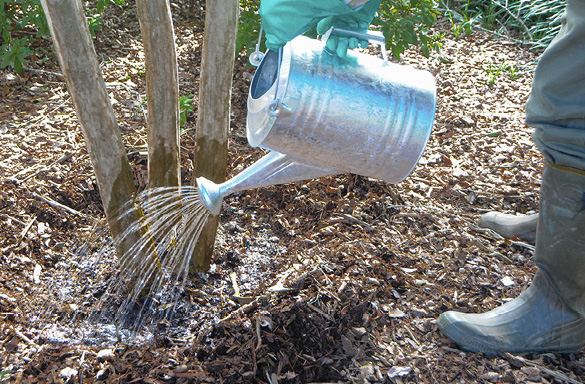
Key Considerations for Using Soil-applied Systemic Insecticide Treatments
- Apply treatments late March through May (optimum time window).
- Treat nearby “uninfested” crape myrtles, also.
- Measure tree trunk(s) in inches circumference/diameter to determine rate.
- For multi-trunk specimens, add measurements of individual trunks.
- For shrub-form specimens, measure height in feet to determine rate.
- Measure trees before buying product so you know how much to buy.
- Mix and apply per label directions.
- Note whether rate is based on trunk circumference or trunk diameter!
- Rake heavy mulch away from tree base before applying soil drenches.
- Observe pollinator protection requirements on label.
- Expect it to take several weeks before control is obtained.
- Expect control to last for the remainder of the season.
- Do not expect sooty mold to disappear quickly after treatment.
- Do not expect 100 percent control.
- Apply soil-applied systemic treatment only once per year.
- Treat again the following year, even if CMBS is not evident.
Application rates for soil-applied systemic insecticides vary considerably depending on the size of the tree and the product being used. Rates for shrub-form specimens are based on the height in feet, while rates for tree-form specimens are based on either the circumference (inches around the trunk) or the diameter of the trunk(s). For multi-trunk specimens, measure individual trunks and combine the measurements. Check product labels carefully. Some products specify rates based on number of inches in trunk circumference, while others are based on trunk diameter. To determine trunk diameter, measure the circumference and divide by three.
Count and Measure Trees before Buying Product
To be sure you buy enough insecticide for the job, measure the trees you plan to treat before going to buy insecticide. It will likely take a lot more product than you might initially think. For example: it will take 18 fluid ounces of the Bonide Annual Tree & Shrub Insect Control product to treat a single small tree with three trunks having a combined measurement of 18 inches in circumference. Mid-sized, multi-trunk trees may have around 40 to 60 inches of total trunk circumference, and large crape myrtles can have total trunk measurements exceeding 100 inches in circumference. Even small, shrub-form specimens require a lot of product. For example: it will take 15 fluid ounces of this product to treat a 5-foot-tall shrub-form crape myrtle. Cost of treatment varies considerably depending on product used, from as little as $2 to more than $40 for a tree with 40 inches of total trunk circumference.

Crawler Sprays with Insect Growth Regulators
For more aggressive control, soil-applied systemic insecticide treatments may be supplemented by applying a series of crawler sprays using insect growth regulator products containing pyriproxyfen or buprofezin. Such sprays must usually be applied by a commercial applicator and are best applied as a series of sprays, spaced about 14 to 21 days apart. These treatments are known to be effective against many other species of scale insects but have not been extensively tested against CMBS. IGR crawler sprays are not recommended as stand-alone treatments for CMBS but can be used as part of a more aggressive control program with the goal of obtaining improved control. In home and commercial landscapes, these IGR insecticides are preferred to other types of crawler sprays because of their reduced risk to lady beetles and other nontarget organisms. In commercial nursery settings, where 100 percent control is required and preservation of beneficial insects is less of a concern, there are additional insecticides that may be useful as crawler sprays to supplement soil-applied systemic treatments. For example, insecticides containing acephate, bifenthrin, beta-cyfluthrin, or other labeled pyrethroids may be applied as crawler sprays per label directions, either alone or as tank mixtures with one of the above insect growth regulators. Observe pollinator protection requirements when applying foliar sprays.
Horticultural Oil Sprays
Although dormant horticultural oil sprays have not been fully tested against CMBS, and it is difficult for the oil to penetrate the felt covering of mature females, dormant oil treatments will help control the more exposed stages, such as crawlers and nymphs. Spray infested trees with horticultural oil after leaf drop in the fall and/or again in the spring before bud break, being sure to observe label directions regarding temperature and application rates. Such treatments are most useful on trees that were found to be infested too late in the year to apply soil-applied systemic treatments, or as supplemental treatments to an aggressive CMBS control program. Do not rely on oil sprays alone to control CMBS.
Sooty Mold Removal
Once control is established, many homeowners and landscape managers desire to remove as much sooty mold as possible to improve aesthetics. One method is to use a soft-bristle brush, water, and a bit of dish washing liquid to scrub heavy accumulations of scale and sooty mold from trunks and lower limbs of heavily infested trees. Some gardeners also use high-pressure water sprays to wash sooty mold from trees, but be sure the pressure is not so high as to damage the tree. This is not a method of control! Most CMBS occur higher in the tree on twigs and limbs that can’t practically be washed. However, trunk washing will improve appearance of the tree and make it easier to monitor the long-term effectiveness of the treatment program (Does CMBS reappear on the trunk, or does more sooty mold build up on the trunk?).
|
Active Ingredient |
Brand Name |
Application Rate |
Comments |
|
2.94% imidacloprid |
BioAdvanced Tree & Shrub Insect Control |
½ fl oz per inch of distance around trunk(s) |
Apply only one application per year. For best results, apply from late March through May. If infestations are detected later in the season, treat promptly, as long as trees retain leaves and are actively growing. Mix with water per label directions and apply to soil around base of tree. Heed pollinator protection requirements specified on product label. Rates shown here are for tree-form specimens. See product label for rates for shrub-form specimens. |
|
1.47% imidacloprid |
Bonide Annual Tree & Shrub Insect Control |
1 fl oz per inch of trunk circumference |
|
|
1.47% imidacloprid |
Fertilome Tree & Shrub Systemic Insect Drench |
1 fl oz per inch of distance around trunk(s) |
|
|
1.47% imidacloprid |
Monterey Once a Year Insect Control II |
1 fl oz per inch of distance around trunk(s) |
|
|
imidacloprid |
Various generic brands |
See label |
|
Active Ingredient |
Brand Name |
Restricted Use? |
Application Rate* |
Comments** |
|
Soil-applied Systemic Insecticides |
||||
|---|---|---|---|---|
|
20% dinotefuran |
Safari 20 SG |
no |
1.25 to 5.0 level teaspoons per inch of trunk diameter |
For best results, apply in late March through May and before plants begin to bloom. Mix with water and apply as a drench or soil injection per label directions. Pull back mulch before drenching. May also be applied as a trunk spray; see label. |
|
10% dinotefuran |
Zylam Liquid Systemic Insecticide |
no |
0.2 to 0.8 fl oz per inch of trunk diameter |
For best results, apply in late March through May and before plants begin to bloom. Mix with water and apply as a drench or soil injection per label directions. Pull back mulch before drenching. May also be applied as a trunk spray; see label. |
|
21.4% imidacloprid (There are many generic formulations of imidacloprid.) |
Criterion 2F, Merit 2F |
no |
0.2 fl oz per inch of trunk diameter |
For best results, apply in late March through May and before plants begin to bloom. Mix with water and apply as a drench or soil injection per label directions. Pull back mulch before drenching. |
|
25% thiamethoxam |
Meridian 25 WG |
no |
2 to 4 grams per inch of trunk diameter |
For best results, apply in late March through May and before plants begin to bloom. Mix with water and apply as a drench or soil injection per label directions. Pull back mulch before drenching. |
|
Insect Growth Regulators for Crawler Sprays |
||||
|
11.23% pyriproxyfen |
Distance, Fulcrum |
no |
8–12 fl oz per 100 gals |
When crawlers are active, apply as a uniform foliar spray. |
|
70% buprofezin |
Talus 70 DF |
no |
14 oz per acre |
When crawlers are active, apply as a foliar spray in sufficient water for complete coverage. |
*Rates shown here are for tree-form specimens. See product label for rates for shrub-form specimens.
**Heed pollinator protection requirements specified on the product label.
References
Gu, M., Merchant, M., Robbins, J., & Hopkins, J. (2014). Crape myrtle bark scale: A new exotic pest (EHT-049 3/14). The Texas A&M University System, Texas A&M AgriLife Extension Service.
Hui, J. . X. (1998). Observation on Eriococcus lagerstroemiae Kuwana. Journal of Anhui Agricultural University, 2.
Jin-hua, M. A. (2011). Occurrence and biological characteristics of Eriococcus lagerstroemiae Kuwana in Panxi district. South China Fruits, 5, 003.
Robbins, J., Hopkins, J., Merchant, M., & Gu, M. (2014). Crape myrtle bark scale: A new insect pest (FSA7086, 4 pp.). University of Arkansas Research and Extension Publication.
Wang, Z., Chen, Y., Knox, G. W., Ring, D., & Diaz, R. (2015). Crape myrtle bark scale. Bug Biz Pest Management and Insect Identification Series, LSU Agricultural Center, Pub. 3440.
This work is partially supported by Crop Protection and Pest Management, Extension Implementation Program grant no. 2017-70006-27200/project accession no. 1014037 from the USDA National Institute of Food and Agriculture. Any opinions, findings, conclusions, or recommendations expressed in this publication are those of the author(s) and do not necessarily reflect the view of the U.S. Department of Agriculture.
The information given here is for educational purposes only. References to commercial products, trade names, or suppliers are made with the understanding that no endorsement is implied and that no discrimination against other products or suppliers is intended.
Publication 2938 (POD-05-23)
By Blake Layton, PhD, Extension Entomologist (retired), Biochemistry, Molecular Biology, Entomology, and Plant Pathology.
The Mississippi State University Extension Service is working to ensure all web content is accessible to all users. If you need assistance accessing any of our content, please email the webteam or call 662-325-2262.

